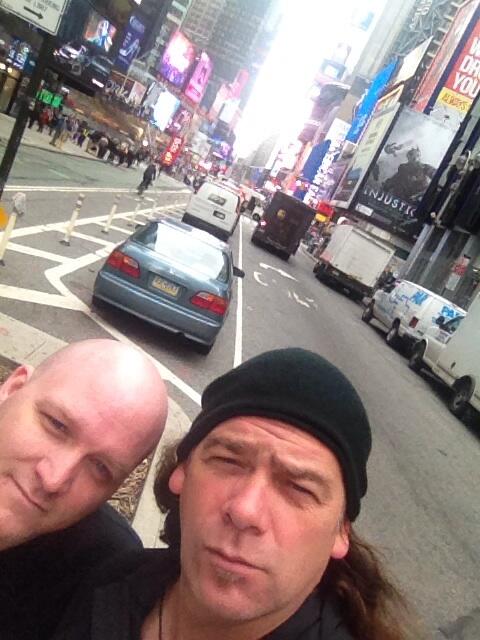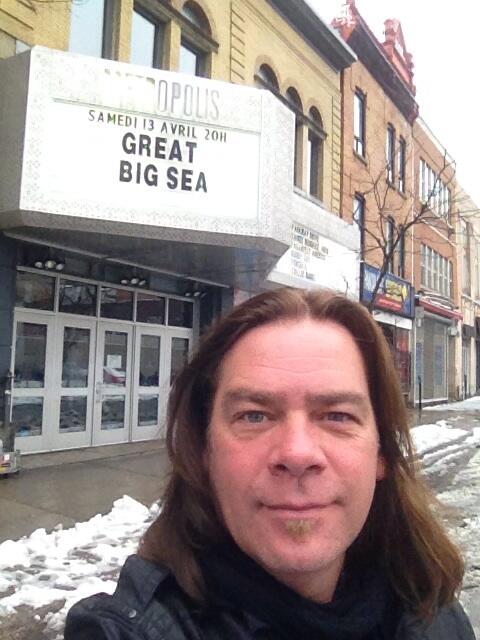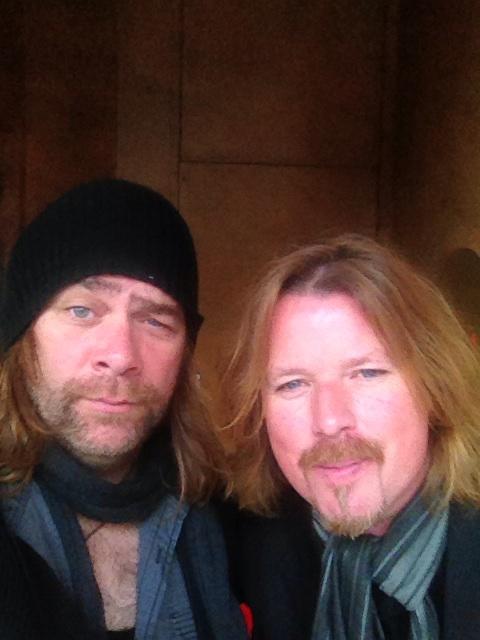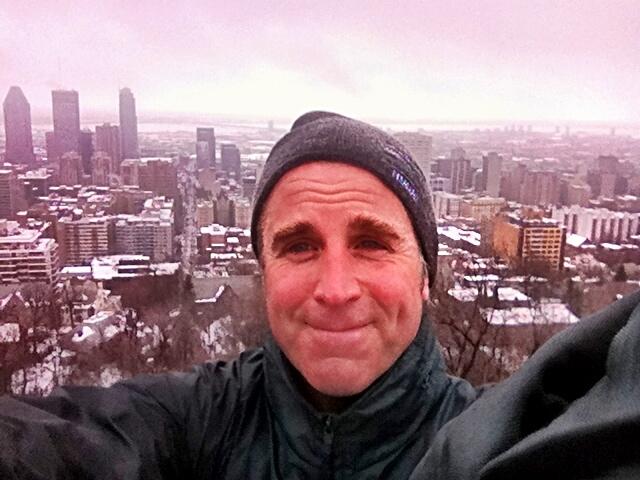Our Great Big Sea boys are no different from other
celebrities who take photos and post them on social media. They take the
occasional wonderful and not so wonderful selfies to tell a story at that
particular time and place and then distribute them via Twitter. I shouldn’t
speak for all the fandom but I love receiving them. Selfies seem to have their
own fandom of people of all ages and across all cultures. So what is a selfie, how did they become so popular and what does a selfie say about people involved in taking them?
I found this really interesting article on selfies in an
Australian newspaper the Advertiser called “Me, my selfie and I” by Elizabeth
Day on the August 16 2013. The article puts selfies within the historical and
social context of popular culture. The article has been edited for copyright
reasons and length.
Also included are seven of my favourite selfies from the Twitter pages of Great Big Sea over the last couple of years (@alanthomasdoyle @bobhallett and @greatbigsean). No copyright infringement intended.







“Me, my selfie and I” by Elizabeth Day on the August 16 2013 at the Advertiser.com.au. (no copyright intended)
Also included are seven of my favourite selfies from the Twitter pages of Great Big Sea over the last couple of years (@alanthomasdoyle @bobhallett and @greatbigsean). No copyright infringement intended.







“Me, my selfie and I” by Elizabeth Day on the August 16 2013 at the Advertiser.com.au. (no copyright intended)
THE smartphone self-portrait
or selfie has established itself as a form of self-expression. Is it a harmless
fad or a dangerous sign of narcissism?
...This, then, is the selfie: the self-portrait of the digital age. We are all at
it. Just type “selfie” into the Twitter search bar. Or look at Instagram, where
more than 90m photos are currently posted with the hashtag #me.
Adolescent pop
poppet Justin Bieber constantly tweets photos of himself with his shirt off to
the shrieking delight of his huge online following. Rihanna has treated her
fans to Instagrammed selfies of her enjoying the view at a strip club, of her
buttocks barely concealed by a tiny denim thong and of her posing with two
oversize cannabis joints while in Amsterdam. Reality TV star Kim Kardashian
overshares to the extent that, in March, she posted a picture of her own face
covered in blood after undergoing a so-called “vampire facial”.
In the same month, the selfie-obsessed model and actress Kelly Brook banned herself from posting any more of them (her willpower lasted two hours). The political classes have started doing it, too. President Obama’s daughters, Sasha and Malia, took selfies at his second inauguration. In June, Hillary Clinton got in on the act after her daughter, Chelsea, tweeted a joint picture of them taken on her phone at arm’s length.…
The trend has even reached outer space: in December, Japanese astronaut Aki Hoshide took what might be the greatest selfie of all time at the International Space Station. The resulting image encompassed the sun, the Earth, two portions of a robotic arm, a spacesuit and the deep darkness of the infinite beyond.
“The selfie is revolutionising how we gather autobiographical information about ourselves and our friends,” says Dr Mariann Hardey, a lecturer in marketing at Durham University who specialises in digital social networks. “It’s about continuously rewriting yourself. It’s an extension of our natural construction of self. It’s about presenting yourself in the best way … [similar to] when women put on make-up or men who bodybuild to look a certain way: it’s an aspect of performance that’s about knowing yourself and being vulnerable.”
Although photographic self-portraits have been around since 1839, when daguerreotype pioneer Robert Cornelius took a picture of himself outside his family’s store in Philadelphia (whether he had the help of an assistant is not known), it was not until the invention of the compact digital camera that the selfie boomed in popularity.
There was some experimentation with the selfie in the 1970s – most notably by Andy Warhol – when the Polaroid camera came of age and freed amateur photographers from the tyranny of the darkroom. But film was expensive and it wasn’t until the advent of digital that photographs became truly instantaneous.
The fact that we no longer had to traipse to our local chemist to develop a roll of holiday snaps encouraged us to experiment – after all, on a digital camera, the image could be easily deleted if we didn’t like the results. A selfie could be done with the timer button or by holding the camera at arm’s length, if you didn’t mind the looming tunnel of flesh dog-earing one corner of the image.
In the same month, the selfie-obsessed model and actress Kelly Brook banned herself from posting any more of them (her willpower lasted two hours). The political classes have started doing it, too. President Obama’s daughters, Sasha and Malia, took selfies at his second inauguration. In June, Hillary Clinton got in on the act after her daughter, Chelsea, tweeted a joint picture of them taken on her phone at arm’s length.…
The trend has even reached outer space: in December, Japanese astronaut Aki Hoshide took what might be the greatest selfie of all time at the International Space Station. The resulting image encompassed the sun, the Earth, two portions of a robotic arm, a spacesuit and the deep darkness of the infinite beyond.
“The selfie is revolutionising how we gather autobiographical information about ourselves and our friends,” says Dr Mariann Hardey, a lecturer in marketing at Durham University who specialises in digital social networks. “It’s about continuously rewriting yourself. It’s an extension of our natural construction of self. It’s about presenting yourself in the best way … [similar to] when women put on make-up or men who bodybuild to look a certain way: it’s an aspect of performance that’s about knowing yourself and being vulnerable.”
Although photographic self-portraits have been around since 1839, when daguerreotype pioneer Robert Cornelius took a picture of himself outside his family’s store in Philadelphia (whether he had the help of an assistant is not known), it was not until the invention of the compact digital camera that the selfie boomed in popularity.
There was some experimentation with the selfie in the 1970s – most notably by Andy Warhol – when the Polaroid camera came of age and freed amateur photographers from the tyranny of the darkroom. But film was expensive and it wasn’t until the advent of digital that photographs became truly instantaneous.
The fact that we no longer had to traipse to our local chemist to develop a roll of holiday snaps encouraged us to experiment – after all, on a digital camera, the image could be easily deleted if we didn’t like the results. A selfie could be done with the timer button or by holding the camera at arm’s length, if you didn’t mind the looming tunnel of flesh dog-earing one corner of the image.
As a result,
images tagged as #selfie began appearing on the photo-sharing website Flickr as
early as 2004. But it was the introduction of smartphones – most crucially the
iPhone 4, which came along in 2010 with a front-facing camera – that made the
selfie go viral.….
Recently, the Chinese manufacturer Huawei unveiled plans for a new smartphone with “instant facial beauty support” software, which reduces wrinkles and blends skin tone.
“A lot of the cameras on smartphones are incredibly good,” says Michael Pritchard, the director general of the Royal Photographic Society. “The rise of digital cameras and the iPhone coincided with the fact that there are a lot more single people around [than before]. The number of single-occupancy households is rising, more people are divorcing and living single lives and people go on holiday by themselves more and don’t have anyone else to take the picture. That’s one reason I take selfies: because I do actually want to record where I am.”…
But Rebecca Brown, a 23-year-old graduate trainee from Birmingham, believes her penchant for selfies is neither degrading nor narcissistic. Instead, she explains, it is a simple means of self-exploration. “It’s almost like a visual diary,” she says. “I can look back and see what I looked like at a particular time, what I was wearing.
“It’s exploring your identity in digital form. To me it’s not about nudity or having a raunchy or raw kind of look… People think if you take pictures of yourself, you’re self-obsessed but that’s like saying if you write a diary or an autobiography, you’re self-obsessed. Not necessarily. A selfie is a format and a platform to share who you are.”
Does she feed off the social approval that a selfie can generate? “I suppose you take photos to see what you look like,” Brown concedes. “Before I go out, I’ll take a couple of pictures almost to see how I look in other people’s eyes. In the same way that if you wrote a really good piece of work and had people commenting about how good it was, or if you put something on Twitter that people retweeted, if people start liking your selfie, then obviously you’re going to get a natural buzz. It gives you a nice boost and you can walk with that little bit more confidence.”
There is nothing new about this, of course. Human beings are social animals and have long been driven by the need for approval and self-affirmation – albeit on a smaller scale. The desire for a pictorial representation of the self goes all the way back to early handprint paintings on cave walls more than 4000 years ago. In a fast-paced world of ever-changing technology, it could be argued that the selfie is simply a natural evolution of those hands dipped in paint.
“As with so many ‘new trends’, this one has a fairly distinguished prehistory,” explains essayist and author Geoff Dyer. “In 1925 DH Lawrence was bemoaning the way that ‘each of us has a complete Kodak idea of himself’. This new phenomenon of the selfie has already been turned into a work of art which is also a sort of visual essay: Richard Misrach’s 11.21.11 5.40pm consists of him taking a telephoto shot of a couple on a beach taking a picture of the sea. Then we zoom in closer and closer on each subsequent page until we are able to see the screen of their phone in which is revealed… a self-portrait.”
Recently, the Chinese manufacturer Huawei unveiled plans for a new smartphone with “instant facial beauty support” software, which reduces wrinkles and blends skin tone.
“A lot of the cameras on smartphones are incredibly good,” says Michael Pritchard, the director general of the Royal Photographic Society. “The rise of digital cameras and the iPhone coincided with the fact that there are a lot more single people around [than before]. The number of single-occupancy households is rising, more people are divorcing and living single lives and people go on holiday by themselves more and don’t have anyone else to take the picture. That’s one reason I take selfies: because I do actually want to record where I am.”…
But Rebecca Brown, a 23-year-old graduate trainee from Birmingham, believes her penchant for selfies is neither degrading nor narcissistic. Instead, she explains, it is a simple means of self-exploration. “It’s almost like a visual diary,” she says. “I can look back and see what I looked like at a particular time, what I was wearing.
“It’s exploring your identity in digital form. To me it’s not about nudity or having a raunchy or raw kind of look… People think if you take pictures of yourself, you’re self-obsessed but that’s like saying if you write a diary or an autobiography, you’re self-obsessed. Not necessarily. A selfie is a format and a platform to share who you are.”
Does she feed off the social approval that a selfie can generate? “I suppose you take photos to see what you look like,” Brown concedes. “Before I go out, I’ll take a couple of pictures almost to see how I look in other people’s eyes. In the same way that if you wrote a really good piece of work and had people commenting about how good it was, or if you put something on Twitter that people retweeted, if people start liking your selfie, then obviously you’re going to get a natural buzz. It gives you a nice boost and you can walk with that little bit more confidence.”
There is nothing new about this, of course. Human beings are social animals and have long been driven by the need for approval and self-affirmation – albeit on a smaller scale. The desire for a pictorial representation of the self goes all the way back to early handprint paintings on cave walls more than 4000 years ago. In a fast-paced world of ever-changing technology, it could be argued that the selfie is simply a natural evolution of those hands dipped in paint.
“As with so many ‘new trends’, this one has a fairly distinguished prehistory,” explains essayist and author Geoff Dyer. “In 1925 DH Lawrence was bemoaning the way that ‘each of us has a complete Kodak idea of himself’. This new phenomenon of the selfie has already been turned into a work of art which is also a sort of visual essay: Richard Misrach’s 11.21.11 5.40pm consists of him taking a telephoto shot of a couple on a beach taking a picture of the sea. Then we zoom in closer and closer on each subsequent page until we are able to see the screen of their phone in which is revealed… a self-portrait.”
The popularity of
the selfie is, says Mariann Hardey, “an extension of how we live and learn
about each other” and a way of imparting necessary information about who we
are. By way of an example, Hardey says that when her father died suddenly last
year, she took refuge in her Instagram feed.
“I couldn’t bear the conversations but one way to prove to friends that I was OK was to take a picture of myself,” she says. “That revealed something very important to my friends – one, that I was still functioning and, two, I was out doing stuff. An image can convey more than words.”…
A selfie can, in some respects, be a more authentic representation of beauty than other media images. In an article for Psychology Today published earlier this year, Sarah J Gervais, an assistant professor of psychology, wrote that: “Instagram (and other social media) has allowed the public to reclaim photography as a source of empowerment… [it] offers a quiet resistance to the barrage of perfect images that we face each day. Rather than being bombarded with those creations… we can look through our Instagram feed and see images of real people – with beautiful diversity.
“Instagram also allows us the opportunity to see below the surface. We capture a glimpse into the makings of people’s daily lives. We get a sense of those things that make the everyday extraordinary.”
The appeal for celebrities like Bieber, Kardashian et al is connected to this. The expansion of social networking has enabled them to communicate directly with their fanbase and to build up large, loyal followings among people who believe they are getting a real glimpse into the lives of the rich and famous.
“If you’re going for a younger audience, you’re expected to engage with every media channel available to you,” says leading PR Mark Borkowski.
“Every aspect of Rihanna’s life is about her letting people in. Some people are very natural and normal about it and completely comfortable with being ‘on’ and that’s fine. But it becomes unstuck if it’s not real. A selfie has to be ‘the real you’. It works if you can give people a manageable piece of reality which is who you are.”
The key is the idea of “manageable reality”: celebrities can now exercise more control than ever over the dissemination of their image. The paradox at the heart of the selfie is that it masquerades as a “candid” shot, taken without access to airbrushing or post-production, but in fact, a carefully posed selfie, edited with all the right filters, is a far more appealing prospect than a snatched paparazzo shot taken from a deliberately unflattering angle.
“It’s about self-exposure and control,” says artist Simon Foxall, whose work questions the parameters of individuality and self-expression. “A selfie blurs the line between ‘reality’ and the performance of a fantasy self, so one collapses into the other.”
Beyond that, a judicious use of selfies can make good business sense too: Alexa Chung and Florence Welch have both used selfies to post daily updates on what they are wearing, thereby cementing their position as modern style icons and guaranteeing, no doubt, the continuation of a series of lucrative fashion deals. (Chung, for one, has designed a women’s wear line for the fashion brand Madewell for the last three years.)
“I couldn’t bear the conversations but one way to prove to friends that I was OK was to take a picture of myself,” she says. “That revealed something very important to my friends – one, that I was still functioning and, two, I was out doing stuff. An image can convey more than words.”…
A selfie can, in some respects, be a more authentic representation of beauty than other media images. In an article for Psychology Today published earlier this year, Sarah J Gervais, an assistant professor of psychology, wrote that: “Instagram (and other social media) has allowed the public to reclaim photography as a source of empowerment… [it] offers a quiet resistance to the barrage of perfect images that we face each day. Rather than being bombarded with those creations… we can look through our Instagram feed and see images of real people – with beautiful diversity.
“Instagram also allows us the opportunity to see below the surface. We capture a glimpse into the makings of people’s daily lives. We get a sense of those things that make the everyday extraordinary.”
The appeal for celebrities like Bieber, Kardashian et al is connected to this. The expansion of social networking has enabled them to communicate directly with their fanbase and to build up large, loyal followings among people who believe they are getting a real glimpse into the lives of the rich and famous.
“If you’re going for a younger audience, you’re expected to engage with every media channel available to you,” says leading PR Mark Borkowski.
“Every aspect of Rihanna’s life is about her letting people in. Some people are very natural and normal about it and completely comfortable with being ‘on’ and that’s fine. But it becomes unstuck if it’s not real. A selfie has to be ‘the real you’. It works if you can give people a manageable piece of reality which is who you are.”
The key is the idea of “manageable reality”: celebrities can now exercise more control than ever over the dissemination of their image. The paradox at the heart of the selfie is that it masquerades as a “candid” shot, taken without access to airbrushing or post-production, but in fact, a carefully posed selfie, edited with all the right filters, is a far more appealing prospect than a snatched paparazzo shot taken from a deliberately unflattering angle.
“It’s about self-exposure and control,” says artist Simon Foxall, whose work questions the parameters of individuality and self-expression. “A selfie blurs the line between ‘reality’ and the performance of a fantasy self, so one collapses into the other.”
Beyond that, a judicious use of selfies can make good business sense too: Alexa Chung and Florence Welch have both used selfies to post daily updates on what they are wearing, thereby cementing their position as modern style icons and guaranteeing, no doubt, the continuation of a series of lucrative fashion deals. (Chung, for one, has designed a women’s wear line for the fashion brand Madewell for the last three years.)
The website What I Wore Today
began as a site that featured young entrepreneur Poppy Dinsey posing for a
daily selfie, in a different outfit for every day of the year. It became an
internet hit and has now expanded to allow users to upload their own images, as
well as generating advertising revenue by featuring online links to clothing
retailers.
“People like the control
selfies give them,” says Dinsey. “Sometimes it’s just a practical matter of not
having anyone around to shoot you and that’s why I always took my own pictures
in mirrors for WIWT. But you’re deciding how to frame yourself – you’re not
trusting someone else to make you look good. With front-facing cameras on
iPhones, and so on, you can see the picture you’re taking and frame it
perfectly to show yourself off as best as possible – your mate isn’t going to
make the same effort when taking your picture. Plus, you can retake and retake
without anyone having to know how much vanity has gone into that ‘casual’
pose.”
In some ways, of course, the notion of control is disingenuous: once a selfie is posted online, it is out there for public delectation. Future employers can see it. Marketers can use it. A resentful former lover could exploit it. You can use digital technology to manipulate your own image as much as you like. But the truth about selfies is that once they are online, you can never control how other people see you.
In some ways, of course, the notion of control is disingenuous: once a selfie is posted online, it is out there for public delectation. Future employers can see it. Marketers can use it. A resentful former lover could exploit it. You can use digital technology to manipulate your own image as much as you like. But the truth about selfies is that once they are online, you can never control how other people see you.
© The Observer 2013
SELFIE - A BRIEF HISTORY by Ian Tucker
2005 The term “selfie” is first used by Richard Krause in a “how-to” photography guide. “The guesswork that goes into selfies often results in serendipitous photographic surprises,” he notes.
Feb 2007 A user of the photo-sharing site Flickr creates a group called “selfie shots”, defining selfie as: “A photograph of oneself in an arm-extended posture. Not to be confused with a photo of oneself in a mirror or other reflected surface.”
June 2010 Apple releases the iPhone 4 featuring a very basic front-facing camera, which was included to enable users to take advantage of video-calling apps such as Apple’s FaceTime and Skype, but also allows users to frame their self-portraits.
Oct 2010 Instagram is launched, reaching more than 100 million active users by April 2012. The app enables people to share photos from their smartphones and enhance them with filters. Since its launch more than 23m photos have been uploaded to the app with the “#selfie” hashtag.
June 2012 Selfie joins the OED’s watchlist of words for possible inclusion. “This colloquial term for a photographic self-portrait has thus far appeared primarily in social media contexts,” it notes.
Dec 2012 Selfie appears in Time magazine’s top buzzwords of 2012. “Selfies are often snapped at odd angles with smartphones and include part of the photographer’s arm,” it observes.
Jan 2013 The Obamas’ daughters, Malia and Sasha, are pictured taking a selfie at their father’s presidential inauguration.
March 2013 The Daily Mail publishes its first moral panic piece about selfies, headlined: “The craze for pouting pictures I fear my daughters will end up regretting.” The writer adds: “It’s as though a whole generation of teenage girls has lost the ability to smile naturally.”
April 2013 The Samsung Galaxy S4 is released, featuring a 2 megapixel front-facing camera.
June 2013 Instagram launches the fourth version of its software, the app’s new 15-second video feature. The age of the selfie movie is upon us…
2005 The term “selfie” is first used by Richard Krause in a “how-to” photography guide. “The guesswork that goes into selfies often results in serendipitous photographic surprises,” he notes.
Feb 2007 A user of the photo-sharing site Flickr creates a group called “selfie shots”, defining selfie as: “A photograph of oneself in an arm-extended posture. Not to be confused with a photo of oneself in a mirror or other reflected surface.”
June 2010 Apple releases the iPhone 4 featuring a very basic front-facing camera, which was included to enable users to take advantage of video-calling apps such as Apple’s FaceTime and Skype, but also allows users to frame their self-portraits.
Oct 2010 Instagram is launched, reaching more than 100 million active users by April 2012. The app enables people to share photos from their smartphones and enhance them with filters. Since its launch more than 23m photos have been uploaded to the app with the “#selfie” hashtag.
June 2012 Selfie joins the OED’s watchlist of words for possible inclusion. “This colloquial term for a photographic self-portrait has thus far appeared primarily in social media contexts,” it notes.
Dec 2012 Selfie appears in Time magazine’s top buzzwords of 2012. “Selfies are often snapped at odd angles with smartphones and include part of the photographer’s arm,” it observes.
Jan 2013 The Obamas’ daughters, Malia and Sasha, are pictured taking a selfie at their father’s presidential inauguration.
March 2013 The Daily Mail publishes its first moral panic piece about selfies, headlined: “The craze for pouting pictures I fear my daughters will end up regretting.” The writer adds: “It’s as though a whole generation of teenage girls has lost the ability to smile naturally.”
April 2013 The Samsung Galaxy S4 is released, featuring a 2 megapixel front-facing camera.
June 2013 Instagram launches the fourth version of its software, the app’s new 15-second video feature. The age of the selfie movie is upon us…



